
i
Programmable AC Source
61501/61502/61503/61504
User’s Manual


Programmable AC Source
61501/61502/61503/61504
User’s Manual
Version 1.6
January 2010

ii
Legal Notices
The information in this document is subject to change without notice.
Chroma ATE INC. makes no warranty of any kind with regard to this manual, including, but
not limited to, the implied warranties of merchantability and fitness for a particular purpose.
Chroma ATE INC. shall not be held liable for errors contained herein or direct, indirect,
special, incidental or consequential damages in connection with the furnishing, performance,
or use of this material.
CHROMA ATE INC.
No.66 Hwa-Ya 1st Rd., Hwa-Ya Technical Park, Kuei-Shan 33383, Taoyuan County, Taiwan
Copyright Notices. Copyright 2002-2010 Chroma ATE INC., all rights reserved. Reproduction,
adaptation, or translation of this document without prior written permission is prohibited,
except as allowed under the copyright laws.

iii
Warranty
All Chroma instruments are warranted against defects in material and workmanship for a
period of one year after date of shipment. Chroma agrees to repair or replace any assembly
or component found to be defective, under normal use during this period. Chroma's
obligation under this warranty is limited solely to repairing any such instrument which in
Chroma's sole opinion proves to be defective within the scope of the warranty when returned
to the factory or to an authorized service center. Transportation to the factory or service
center is to be prepaid by the purchaser. Shipment should not be made without prior
authorization by Chroma.
This warranty does not apply to any products repaired or altered by persons not authorized
by Chroma, or not in accordance with instructions furnished by Chroma. If the instrument is
defective as a result of misuse, improper repair, or abnormal conditions or operations, repairs
will be billed at cost.
Chroma assumes no responsibility for its product being used in a hazardous or dangerous
manner either alone or in conjunction with other equipment. High voltage used in some
instruments may be dangerous if misused. Special disclaimers apply to these instruments.
Chroma assumes no liability for secondary charges or consequential damages and in any
event, Chroma's liability for breach of warranty under any contract or otherwise, shall not
exceed the purchase price of the specific instrument shipped and against which a claim is
made.
Any recommendations made by Chroma for use of its products are based upon tests
believed to be reliable, but Chroma makes no warranty of the results to be obtained. This
warranty is in lieu of all other warranties, expressed or implied, and no representative or
person is authorized to represent or assume for Chroma any liability in connection with the
sale of our products other than set forth herein.
CHROMA ATE INC.
No. 66 Hwa-Ya 1st Rd, Hwa-Ya Technical Park,
Kuei-Shan 33383, Taoyuan County, Taiwan
Tel: 886-3-327-9999
Fax: 886-3-327-2886
e-mail: [email protected]
http://www.chromaate.com

iv
Material Contents Declaration
A regulatory requirement of The People’s Republic of China defined by specification SJ/T
11364-2006 mandates that manufacturers provide material contents declaration of electronic
products, and for Chroma products are as below:
Hazardous Substances
Lead Mercury Cadmium Hexavalent
Chromium
Polybrominated
Biphenyls
Polybromodiphenyl
Ethers
Part Name
Pb Hg Cd Cr
6+
PBB PBDE
PCBA
°
O O O O O
CHASSIS
°
O O O O O
ACCESSORY
°
O O O O O
PACKAGE
O O O O O O
“O” indicates that the level of the specified chemical substance is less than the threshold level
specified in the standards of SJ/T-11363-2006 and EU 2005/618/EC.
“°” indicates that the level of the specified chemical substance exceeds the threshold level
specified in the standards of SJ/T-11363-2006 and EU 2005/618/EC.
1. Chroma is not fully transitioned to lead-free solder assembly at this moment; however,
most of the components used are RoHS compliant.
2. The environment-friendly usage period of the product is assumed under the operating
environment specified in each product’s specification.
Disposal
Do not dispose of electrical appliances as unsorted municipal waste, use separate collection
facilities. Contact your local government for information regarding the collection systems
available. If electrical appliances are disposed of in landfills or dumps, hazardous substances
can leak into the groundwater and get into the food chain, damaging your health and
well-being. When replacing old appliances with new one, the retailer is legally obligated to
take back your old appliances for disposal at least for free of charge.

v

vi
Safety Summary
The following general safety precautions must be observed during all phases of operation,
service, and repair of this instrument. Failure to comply with these precautions or specific
WARNINGS given elsewhere in this manual will violate safety standards of design,
manufacture, and intended use of the instrument. Chroma assumes no liability for the
customer’s failure to comply with these requirements.
BEFORE APPLYING POWER
Verify that the power is set to match the rated input of this power
supply.
PROTECTIVE GROUNDING
Make sure to connect the protective grounding to prevent an
electric shock before turning on the power.
NECESSITY OF PROTECTIVE GROUNDING
Never cut off the internal or external protective grounding wire, or
disconnect the wiring of protective grounding terminal. Doing so
will cause a potential shock hazard that may bring injury to a
person.
FUSES
Only fuses with the required rated current, voltage, and specified
type (normal blow, time delay, etc.) should be used. Do not use
repaired fuses or short-circuited fuse holders. To do so could
cause a shock or fire hazard.
DO NOT OPERATE IN AN EXPLOSIVE ATMOSPHERE
Do not operate the instrument in the presence of flammable
gases or fumes. The instrument should be used in an
environment of good ventilation.
DO NOT REMOVE THE COVER OF THE INSTRUMENT
Operating personnel must not remove the cover of the instrument.
Component replacement and internal adjustment can be done
only by qualified service personnel.
WARNING
1. Lethal voltage. AC source may output 426 V peak voltage.
2. Touching the connected circuit or output terminal on the front or
rear panel when power is on may result in death.

vii
Safety Symbols
DANGER – High voltage.
Explanation: To avoid injury, death of personnel, or damage to
the instrument, the operator must refer to an explanation in the
instruction manual.
High temperature: This symbol indicates the temperature is now
higher than the acceptable range of human. Do not touch it to
avoid any personal injury.
Protective grounding terminal: To protect against electrical shock
in case of a fault. This symbol indicates that the terminal must be
connected to ground before operation of equipment.
WARNING
The WARNING sign denotes a hazard. It calls attention to a
procedure, practice, or the like, which, if not correctly performed or
adhered to, could result in personal injury. Do not proceed beyond
a WARNING sign until the indicated conditions are fully understood
and met.
CAUTION
The CAUTION sign denotes a hazard. It may result in personal
injury or death if not noticed timely. It calls attention to
procedures, practices and conditions.
ACOUSTIC NOISE INFORMATION
This product has a sound pressure emission (at the operator’s side) < 65dB(A).

viii
Protection Plates
In order to protect the terminals of the Chroma 61500/61600 AC power source from damage
during shift or transportation, users can choose to install the enclosed rear panel protection
plates (2 pieces) as an option.
Installation Instruction:
1. Remove the 4 screws from both sides of the rear panel (Figure 1).
2. Mount the protection plates with the screws included in the bag (Figure 2).
Figure 1
Figure 2

ix
Revision History
The following lists the additions, deletions and modifications in this manual at each revision.
Date Version Revised Sections
Jan. 2002 1.0 Complete this manual.
Jan. 2004 1.1 Modify “Rear Panel”
“DATALOCK”
“COUPLE Mode of Output (AC+DC, AC, DC)”
“Programmable Output Impedance”
“THREE PHASE MODE”
“PARALLEL MODE”
“Synthesis Waveform”
“Interharmonics Waveform”
“The GPIB Capability of the AC Source”
May 2005 1.2 Change the address and phone no. of Chroma
Aug. 2005 1.3 Modify “Rear Panel”
“Input Connection”
“Remote Sense Connection”
“COUPLE Mode of Output (AC+DC, AC, DC)”
“THREE PHASE MODE”
“PARALLEL MODE”
June 2007 1.4 Add the following
− “Material Contents Declaration”
− “Protection Plates”
− “HIGH VOLTAGE OPTION”.
− the description of “NOTICE” in the section of “OUTPUT
RELAY”
Modify the following chapters
− the figure 3-1 in the section of “Operation through Keypad and
RPG”.
− “the definition of letters” in the section of “MAIN PAGE (Output
Setting and Measurement)”.
− the content and notice in the section of “RANGE”.
− “CALIBRATION CHOICE PAGE” in the section of “MANUAL
CALI Functional List”.
− the waveform and table list in the section of “Appendix B
Built-in Waveforms”.
Mar. 2008 1.5
Add the following
– the description in the section of “Slew Rate of Output
Transient”.
– Notice in the section of “HIGH VOLTAGE OPTION”.
– the description in the section of “Appendix A: Pin Assignment
of TTL SIGNAL”.
Modify the following sections:
– Range of OUTPUT IMPEDANCE in the section of
“Specifications”.
– the second page display in the section of “OUTPUT Functional
List”.
– DST17 in the section of “Appendix B Built-in Waveforms”.
Jan. 2010 1.6 Modify the following sections:
– the description in the section of “Procedures of Power-on”.

x
– the description in the section of “Output Voltage and Voltage
Measurement Calibration”.
– the content of “CE Declaration”.

Programmable AC Source 61501/61502/61503/61504 User’s Manual
xi
Table of Contents
1. General Information ................................................................................................1-1
1.1 Introduction............................................................................................................1-1
1.2 Key Features.........................................................................................................1-1
1.3 Specifications ........................................................................................................1-1
1.4 Names of Parts......................................................................................................1-3
1.4.1 Front Panel ................................................................................................1-3
1.4.2 Rear Panel.................................................................................................1-5
2. Installation................................................................................................................2-1
2.1 Inspection..............................................................................................................2-1
2.2 Preparation for the Use .........................................................................................2-1
2.3 Requirements of Input Power................................................................................2-1
2.3.1 Ratings.......................................................................................................2-1
2.3.2 Input Connection........................................................................................2-1
2.4 Output Connection.................................................................................................2-3
2.5 Remote Sense Connection....................................................................................2-3
2.6 Procedures of Power-on........................................................................................2-4
2.7 I/O Connectors (Option) ........................................................................................2-5
3. Local Operation.......................................................................................................3-1
3.1 Introduction............................................................................................................3-1
3.2 Operation through Keypad and RPG.....................................................................3-1
3.3 MAIN PAGE (Output Setting and Measurement) ..................................................3-4
3.4 CHOICE PAGE (Functional List Choice)...............................................................3-5
3.5 SETUP Functional List ..........................................................................................3-5
3.5.1 RANGE......................................................................................................3-6
3.5.2 Vac LIMIT...................................................................................................3-7
3.5.3 Vdc LIMIT (+), Vdc LIMIT (-)......................................................................3-7
3.5.4 I LIMIT, DELAY..........................................................................................3-8
3.5.5 OUTPUT RELAY .......................................................................................3-9
3.5.6 BUZZER.....................................................................................................3-9
3.5.7 DATALOCK................................................................................................3-9
3.5.8 Is START, Is INTERVAL..........................................................................3-10
3.6 CONF Functional List..........................................................................................3-10
3.6.1 REMOTE INHIBIT....................................................................................3-11
3.6.2 EXT. V, COUPLE.....................................................................................3-12
3.6.3 WAVEFORM GENERATOR....................................................................3-13
3.6.4 POWER ON STATUS..............................................................................3-14
3.6.5 GPIB Address, RS-232C .........................................................................3-15
3.7 OUTPUT Functional List......................................................................................3-15
3.7.1 COUPLE Mode of Output (AC+DC, AC, DC) ..........................................3-16
3.7.2 OUTPUT DEGREE..................................................................................3-18
3.7.3 Programmable Output Impedance...........................................................3-18
3.7.4 Slew Rate of Output Transient.................................................................3-19
3.7.5 HIGH VOLTAGE OPTION.......................................................................3-20
3.7.6 THREE PHASE MODE............................................................................3-21
3.7.7 PARALLEL MODE...................................................................................3-23
3.8 Save and Recall ..................................................................................................3-25
3.8.1 Save and Recall Output Setting...............................................................3-25
3.8.2 Save and Recall System Data.................................................................3-27
3.9 Protection ............................................................................................................3-28
4. Calibration................................................................................................................4-1

Programmable AC Source 61501/61502/61503/61504 User’s Manual
xii
4.1
Introduction............................................................................................................4-1
4.2 MANUAL CALI Functional List...............................................................................4-1
4.2.1 Output Voltage and Voltage Measurement Calibration..............................4-3
4.2.2 Current Measurement Calibration..............................................................4-5
4.2.3 External Vref Calibration............................................................................4-7
5. Application...............................................................................................................5-1
5.1 General..................................................................................................................5-1
5.2 List Mode...............................................................................................................5-1
5.3 Pulse Mode............................................................................................................5-4
5.4 Step Mode.............................................................................................................5-7
5.5 Harmonic Measurement........................................................................................5-9
5.6 Synthesize Waveform..........................................................................................5-11
5.7 Interharmonics Waveform....................................................................................5-13
6. Theory of Operation................................................................................................6-1
6.1 General..................................................................................................................6-1
6.2 Description of Overall System...............................................................................6-1
7. Self Test & Troubleshooting...................................................................................7-1
7.1 General..................................................................................................................7-1
7.2 Self Test ................................................................................................................7-1
7.3 Troubleshooting.....................................................................................................7-2
8. Remote Operation ...................................................................................................8-1
8.1 General Information...............................................................................................8-1
8.1.1 Setting the GPIB Address and RS-232C Parameters................................8-1
8.1.2 Wire Connection of RS-232C.....................................................................8-1
8.2 The GPIB Capability of the AC Source..................................................................8-2
8.3 Introduction to Programming.................................................................................8-3
8.3.1 Conventions...............................................................................................8-3
8.3.2 Numerical Data Formats............................................................................8-3
8.3.3 Boolean Data Format.................................................................................8-3
8.3.4 Character Data Format..............................................................................8-3
8.3.5 Basic Definition..........................................................................................8-4
8.4 Traversal of the Command Tree............................................................................8-5
8.5 Execution Order.....................................................................................................8-5
8.6 The Commands of the AC Source.........................................................................8-6
8.6.1 Common Command Dictionary..................................................................8-6
8.6.2 Instrument Command Dictionary ...............................................................8-7
8.7 Command Summary............................................................................................8-30
Appendix A Pin Assignment of TTL Signal...............................................................A-1
Appendix B Built-in Waveforms.................................................................................B-1

General Information
1-1
1. General Information
1.1 Introduction
The series of Chroma AC source 61501/61502/61503/61504 are high efficiency AC power
source which provide sine wave output with low distortion, and accurate measurement of
power. The DSP microprocessor generates accurate, stable output voltage and frequency.
The PWM design of power stage allows for full volt-ampere into loads. The front panel has
both RPG (rotary pulse generator) and keypad controls for setting the output voltage and
frequency. The LCD provides a complete operating state of the unit to the user. Remote
programming is accomplished either through the GPIB bus or the RS-232C serial port.
1.2 Key Features
A. Configuration
z Local operation from the keypad on the front panel.
z Remote operation via GPIB or RS-232C interface.
z Protection against Over-power, Over-Current, Over-temperature, Fan-fail.
z Temperature-controlled fan speed.
z Built-in output isolation relays.
B. Input/Output
z Selective output voltage with full scale of 150V/300V/600V/Auto where 600V is for
A615003 fixture only.
z Remote control by the use of analog voltage reference.
z Universal of input voltage range 90Vac ~ 250Vac.
z Measurement of V, I, P, CF, PF, Idc, Vdc, Ipk, Is, VA and VAR.
z Remotely inhibited control.
z AC ON/OFF output signal.
1.3 Specifications
The operation specifications of the model 61501/61502/61503/61504 are listed below (on the
next page). All specifications have been tested according to the standard Chroma test
procedures. All specifications are based on a remote sense connection, 25 ± 1°C, and
resistor load unless specified otherwise.

Programmable AC Source 61501/61502/61503/61504 User’s Manual
1-2
Model 61501 61502 61503 61504
AC OUTPUT RATING
Max. power 500 VA 1K VA 1.5K VA 2K VA
Voltage
Range 150V / 300V / Auto
Accuracy 0.2%+0.2%F.S. 0.2%+0.2%F.S. 0.2%+0.2%F.S. 0.2%+0.2%F.S.
Resolution 0.1 V 0.1 V 0.1 V 0.1 V
Distortion
0.3% @50/60Hz
1% 15- 1K Hz
0.3% @50/60Hz
1% 15- 1K Hz
0.3% @50/60Hz
1% 15- 1K Hz
0.3% @50/60Hz
1% 15- 1K Hz
Line regulation 0.1% 0.1% 0.1% 0.1%
Load regulation 0.2% 0.2% 0.2% 0.2%
Temp. coefficient
0.02% per degree from 25°C
Maximum current
r.m.s. 4A / 2A 8A / 4A 12A / 6A 16A / 8A
peak 24A / 12A 48A / 24A 72A / 36A 96A / 48A
Frequency
Range DC, 15-1K Hz DC, 15-1K Hz DC, 15-1K Hz DC, 15-1K Hz
Accuracy 0.15% 0.15% 0.15% 0.15%
DC OUTPUT RATING
Power 250W 500W 750W 1K W
Voltage 212V / 424V 212V / 424V 212V / 424V 212V / 424V
Current 2A / 1A 4A / 2A 6A / 3A 8A / 4A
OUTPUT IMPEDANCE
Range
0.0Ω+200uH - 1.0Ω+1.0mH
HARMONICS & SYNTHESIS SIMULATION
Bandwidth 50Hz / 60Hz 40 order
INPUT RATING
Voltage range 90-250V 90-250V 90-250V 90-250V
Frequency range 47-63 Hz 47-63 Hz 47-63 Hz 47-63 Hz
Current 8A Max. 16A Max. 21A Max. 28A Max.
Power factor 0.97 Min. 0.98 Min. 0.98 Min. 0.98 Min.
MEASUREMENT
Voltage
Range 150V / 300V 150V / 300V 150V / 300V 150V / 300V
Accuracy 0.2%+0.2%F.S. 0.2%+0.2%F.S. 0.2%+0.2%F.S. 0.2%+0.2%F.S.
Resolution 0.1 V 0.1 V 0.1 V 0.1 V
Current
Range (peak) 24A 48A 72A 96A
Accuracy (r.m.s.) 0.4%+0.3%F.S. 0.4%+0.3%F.S. 0.4%+0.3%F.S. 0.4%+0.3%F.S.
Accuracy (peak) 0.4%+0.6%F.S. 0.4%+0.6%F.S. 0.4%+0.6%F.S. 0.4%+0.6%F.S.
Resolution 0.01 A 0.01 A 0.01 A 0.01 A
Power
Accuracy 0.4%+0.4% F.S. 0.4%+0.4% F.S. 0.4%+0.4% F.S. 0.4%+0.4% F.S.
Resolution 0.1 W 0.1 W 0.1 W 0.1 W
OTHERS
Efficiency 68 % 77 % 78 % 80 %
Size (H×W×D) 133.35 × 482.6 × 569.5 mm / 5.25 × 19 × 22.42 inch
Weight
20 kg / 44.05 lbs 20 kg / 44.05 lbs 20 kg / 44.05 lbs 20 kg / 44.05 lbs
Protection UVP, OCP, OPP, OTP, FAN

General Information
1-3
Temperature Range
Operation
0 °C to 40 °C
Storage
-40 °C to 85 °C
Humidity 30 % to 90 %
Safety & EMC FCC 15J class A, CE
Remarks
*1: Maximum distortion is tested on output 125VAC (150V RANGE) and 250VAC
(300V RANGE) with maximum current to linear load.
*2: Load regulation is tested with sinewave and remote sense.
*3: Efficiency is tested on input voltage 110V.
1.4 Names of Parts
1.4.1 Front Panel
1
2
3 4 5
67
8
9
10
11
Figure 1-1 Front Panel

Programmable AC Source 61501/61502/61503/61504 User’s Manual
1-4
Table 1-1 Description of Front Panel
Item Symbol Description
1 Display: The LCD is to display configuration, output setup,
and measurement results.
2 Indicator LED: "OUT" and "SHIFT", for showing activation
of output and shift mode, are available which are located
on the keypad area next to the corresponding keys.
3
t
----------or---------
PAGE
PAGE
Cursor moving keys: These two keys are to move the
cursor to different directions respectively. In normal
mode, pressing any of these two keys will change the
place of the cursor. Under shift mode, these keys enable
the LCD display to change to last page or next page if
there are or patterns in right-down side of display.
4
PAGE/EXIT
-----------or----------
SAVE
PAGE or EXIT command key: Pressing this key will
make the LCD display switching between MAIN PAGE
and CHOICE PAGE. Or change to CHOICE PAGE in
each functional list. Under shift mode, pressing this key
on MAIN PAGE, the uses can save the output setting
(see 3.8.1). If pressing the key on CHOICE PAGE, the
user can save system data (see 3.8.2).
5
Õ / -
-----------or----------
RECALL
Backspace and Minus command key: Pressing this key
will erase the keyin number. Or it may show " - ", if no
number is in front of cursor. Under shift mode, pressing
the key on MAIN PAGE, the user can recall the output
setting (see 3.8.1). If pressing the key on CHOICE
PAGE, the user can recall system data (see 3.8.2).
6
OUT/QUIT
OUT/QUIT command key: Pressing this key may enable
the ac source output voltage or quit the output voltage.
7
SHIFT
Shift mode selection key: Pressing this key will switch the
ac source from normal operational mode to the shift mode.
8
0 to 9 , and •
-------------or------------
HELP
Numeric and decimal keys: The user can program
numeric data by pressing the digital keys and the decimal
key. Under shift mode, pressing • acts the HELP
function. The LCD display will show more information
about cursor locating place.
9
ENTER
ENTER key: It is to confirm the setting of parameters.
10
RPG: The user can input programming data or options by
turning the RPG to the desired ones.
11 Main power switch: It is to power on or off.

General Information
1-5
1.4.2 Rear Panel
Figure 1-2 Rear Panel
Table 1-2 Description of Rear Panel
Item Name Description
1 Label The label includes model number, series number of the AC source.
2 Ext. Ref.
The BNC connector inputs control waveform amplitude from
external analog signal.
3
RS-232C
The 9-pin, D-type female connector transfers control commands to
and from the remote PC for remote operation.
4 GPIB Connector
A remote controller using GPIB bus is connected to the AC source
through this connector for remote operation.
5
TTL Signal The 9-pin, female connector transfers control signals (fault_out,
remote inhibit, and AC_ON).
6 SCLK, PWM,
SYNC
The BNC connectors SCLK and PWM are for AC source parallel
connectivity only. SYNC transfers a pulse signal synchronously
when output changes. It also sends synchronizing signal for
3-phase mode operation.
7 Output Connector This connector outputs power to the loading device.
8 Remote Sense
Connector
It senses directly at the terminals of the load to eliminate any
voltage drop on the connecting cable. Make sure of connecting
the terminal “SL” of the remote sense connector to the terminal “L”
of the load, and the “SN” to the “N” of the load. Reverse polarity is
not allowed.
9 Power Line Power line input is connected to AC source through this connector.
10 Power Switch It enables or disables the main power switch. Users can power on
or off with the main power switch when the power switch is set to
“ENABLE”. Conversely the main power switch is inactive when the
power switch on the front panel is set to “DISABLE”.

Page is loading ...
Page is loading ...
Page is loading ...
Page is loading ...
Page is loading ...
Page is loading ...
Page is loading ...
Page is loading ...
Page is loading ...
Page is loading ...
Page is loading ...
Page is loading ...
Page is loading ...
Page is loading ...
Page is loading ...
Page is loading ...
Page is loading ...
Page is loading ...
Page is loading ...
Page is loading ...
Page is loading ...
Page is loading ...
Page is loading ...
Page is loading ...
Page is loading ...
Page is loading ...
Page is loading ...
Page is loading ...
Page is loading ...
Page is loading ...
Page is loading ...
Page is loading ...
Page is loading ...
Page is loading ...
Page is loading ...
Page is loading ...
Page is loading ...
Page is loading ...
Page is loading ...
Page is loading ...
Page is loading ...
Page is loading ...
Page is loading ...
Page is loading ...
Page is loading ...
Page is loading ...
Page is loading ...
Page is loading ...
Page is loading ...
Page is loading ...
Page is loading ...
Page is loading ...
Page is loading ...
Page is loading ...
Page is loading ...
Page is loading ...
Page is loading ...
Page is loading ...
Page is loading ...
Page is loading ...
Page is loading ...
Page is loading ...
Page is loading ...
Page is loading ...
Page is loading ...
Page is loading ...
Page is loading ...
Page is loading ...
Page is loading ...
Page is loading ...
Page is loading ...
Page is loading ...
Page is loading ...
Page is loading ...
Page is loading ...
Page is loading ...
Page is loading ...
Page is loading ...
Page is loading ...
Page is loading ...
Page is loading ...
Page is loading ...
Page is loading ...
Page is loading ...
Page is loading ...
Page is loading ...
Page is loading ...
Page is loading ...
Page is loading ...
Page is loading ...
Page is loading ...
Page is loading ...
Page is loading ...
Page is loading ...
Page is loading ...
Page is loading ...
Page is loading ...
Page is loading ...
Page is loading ...
Page is loading ...
Page is loading ...
Page is loading ...
Page is loading ...
Page is loading ...
Page is loading ...
Page is loading ...
Page is loading ...
Page is loading ...
Page is loading ...
Page is loading ...
Page is loading ...
Page is loading ...
Page is loading ...
Page is loading ...
-
 1
1
-
 2
2
-
 3
3
-
 4
4
-
 5
5
-
 6
6
-
 7
7
-
 8
8
-
 9
9
-
 10
10
-
 11
11
-
 12
12
-
 13
13
-
 14
14
-
 15
15
-
 16
16
-
 17
17
-
 18
18
-
 19
19
-
 20
20
-
 21
21
-
 22
22
-
 23
23
-
 24
24
-
 25
25
-
 26
26
-
 27
27
-
 28
28
-
 29
29
-
 30
30
-
 31
31
-
 32
32
-
 33
33
-
 34
34
-
 35
35
-
 36
36
-
 37
37
-
 38
38
-
 39
39
-
 40
40
-
 41
41
-
 42
42
-
 43
43
-
 44
44
-
 45
45
-
 46
46
-
 47
47
-
 48
48
-
 49
49
-
 50
50
-
 51
51
-
 52
52
-
 53
53
-
 54
54
-
 55
55
-
 56
56
-
 57
57
-
 58
58
-
 59
59
-
 60
60
-
 61
61
-
 62
62
-
 63
63
-
 64
64
-
 65
65
-
 66
66
-
 67
67
-
 68
68
-
 69
69
-
 70
70
-
 71
71
-
 72
72
-
 73
73
-
 74
74
-
 75
75
-
 76
76
-
 77
77
-
 78
78
-
 79
79
-
 80
80
-
 81
81
-
 82
82
-
 83
83
-
 84
84
-
 85
85
-
 86
86
-
 87
87
-
 88
88
-
 89
89
-
 90
90
-
 91
91
-
 92
92
-
 93
93
-
 94
94
-
 95
95
-
 96
96
-
 97
97
-
 98
98
-
 99
99
-
 100
100
-
 101
101
-
 102
102
-
 103
103
-
 104
104
-
 105
105
-
 106
106
-
 107
107
-
 108
108
-
 109
109
-
 110
110
-
 111
111
-
 112
112
-
 113
113
-
 114
114
-
 115
115
-
 116
116
-
 117
117
-
 118
118
-
 119
119
-
 120
120
-
 121
121
-
 122
122
-
 123
123
-
 124
124
-
 125
125
-
 126
126
-
 127
127
-
 128
128
-
 129
129
-
 130
130
-
 131
131
-
 132
132
-
 133
133
-
 134
134
Chroma 61502 User manual
- Category
- Measuring, testing & control
- Type
- User manual
Ask a question and I''ll find the answer in the document
Finding information in a document is now easier with AI
Related papers
-
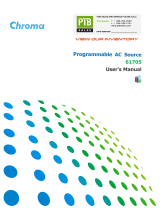 Chroma 61705 User manual
Chroma 61705 User manual
-
Chroma A620027 Operating & Programming Manual
-
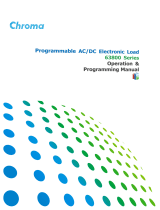 Chroma 63802 Operation & Programming Manual
Chroma 63802 Operation & Programming Manual
-
 Chroma 19572 User manual
Chroma 19572 User manual
-
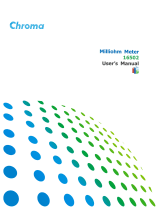 Chroma 16502 User manual
Chroma 16502 User manual
-
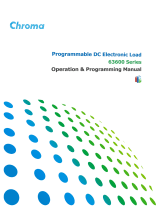 Chroma 63610-80-20 Operation & Programming Manual
Chroma 63610-80-20 Operation & Programming Manual
-
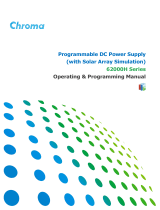 Chroma 62000H Series Operating & Programming Manual
Chroma 62000H Series Operating & Programming Manual
-
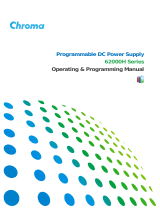 Chroma 62150H-600 Operating & Programming Manual
Chroma 62150H-600 Operating & Programming Manual
-
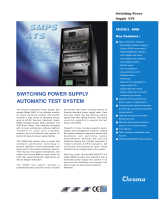 Chroma 8000 User manual
Chroma 8000 User manual
-
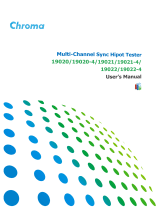 Chroma 19022-4 User manual
Chroma 19022-4 User manual
Other documents
-
Anritsu MS9710C Operating instructions
-
 Stanford Research Systems SR810 User manual
Stanford Research Systems SR810 User manual
-
SEFRAM BK 8500B Series User manual
-
Delta Electronics PFC2815V User manual
-
UNI-T UT243 User manual
-
Promax GF-232B Reference guide
-
VOLTCRAFT DSP-3005V User manual
-
Itech Power meter [IT9121, IT9121H, IT9121C, IT9121E] User manual
-
BK Precision 8540 User manual
-
BK Precision 8540 User manual















































































































































